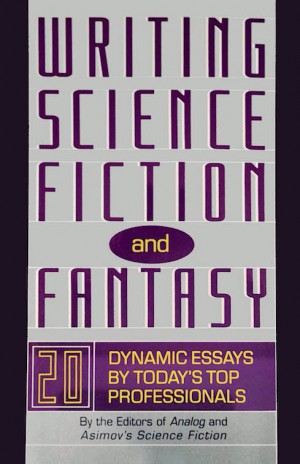Book Tour: Writing Science Fiction & Fantasy, Ch. 8
Sometimes I run across an older book that’s usually out-of-print, but has exceptional wisdom locked up in its pages. I found this one at my local Half Priced Books.

The very nature of this book—20 essays about writing by the best SFF authors—makes it hard to review as a whole. I think a better strategy is to look at each chapter in detail.
See all of my WSF&F chapter reviews.
Chapter 8: Learning to Write Comedy or Why It’s Impossible and How to Do It
Connie Willis, who has won of eleven Hugo Awards and seven Nebula Awards for her comedic science fiction, writes about what makes comedy tick in chapter 8.
She starts by dissecting two myths of writing comedy:
- That comedy writing is fun, where the author’s daily output is being held back by their bouts of uncontrollable laughter. (Hint: it’s the other way around.)
- That analyzing a joke makes it unfunny, in which this myth fails to account for the fact that it’s usually unfunny jokes that need explaining.
The most important point in this chapter is the need for comedic writing to be clear. Serious prose tolerates ambiguity, but if it creeps into comedy the result is disaster. By fumbling the setup, the point of the joke is lost. Everyone knows someone like this, that person who forgets the details, skips to the punchline and still expects a laugh. Unsurprisingly, they tend to live their life in the same way.
Willis also addresses the idea that comedy can’t be taught. An idea that she mostly agrees with. But it can be learned. The difference is subtle and lies within the author. There is no magic formula that can be passed down to aspiring writers. Comedy is learned by reading comedy. The more exposure, the more absorbed. When the writer has absorbed a critical mass, they will have sense of what works and what doesn’t. Or explode. The result is oftentimes indistinguishable.
The bulk of the chapter consists of examples from the masters of comedy throughout the ages, Shakespeare, Twain, Wodehouse, Jerome and the appropriately named Lafferty.
She does dispel another myth. The one of that there is a comic situation. The situation just is. It’s the writing that makes it either serious or funny.
The various types of comedy writing are shown with the examples.
- Creative comparisons
- Puns
- Witty banter
- Exaggeration
- Understatement
- Divergence/misdirection
Sometimes, there’s no one piece of the story that’s funny on its own. But the ending pulls it together so that the entire piece is funny.
A capper is one final joke, the one that sends the reader over the edge. It’s not necessarily the funniest joke in the piece, but the one last straw that breaks the camel’s back. In movies and plays people will frequently smile or giggle intermittently throughout a scene and the burst out loudly at the end. The are not really laughing at the capper. They are laughing at the cumulative effect of the entire scene, which somehow the capper has summed up.
Willis has peppered the chapter with her own brand of humor, which drives home the point that comedy must be studied, not taught.
